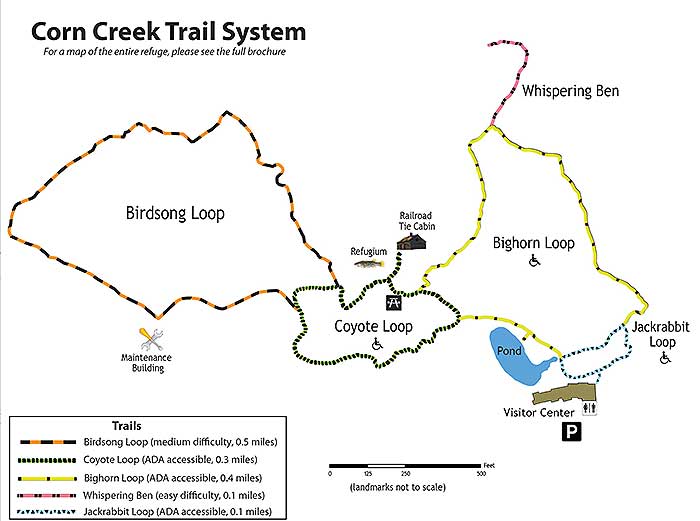Corn Creek
Desert National Wildlife Range
Corn Creek Springs was purchased by the U.S. Government to use as a field station for the Desert National Wildlife Range which is part of the national wildlife refuge system.
The Desert National Wildlife Refuge was established May 20, 1936, and encompasses 1.5 million acres of the diverse Mojave Desert in southern Nevada. It is the largest National Wildlife Refuge in the lower 48 states. The Refuge contains six major mountain ranges, the highest rising from 2,500-foot valleys to nearly 10,000 feet. Annual rainfall ranges from less than four inches on the valley floors to over fifteen inches on the highest peaks.
Perpetuating the desert bighorn sheep and its habitat is the most important objective of the range. The Refuge actively improves bighorn habitats by developing new water sources and maintaining and improving existing ones. Numerous other wildlife species share the range with bighorns.

Railroad Tie Cabin
Take a peek at the endangered Pahrump poolfish in our refugium on your way to the Railroad Tie Cabin. Built with railroad ties from the abandoned Las Vegas & Tonopah Railroad, old scars from the railroad spikes still mark the walls of this 1920s historic home.
The best time to view wildlife at Corn Creek is during the Spring, Summer and Fall months. There is a visitors center/contact station where visitors can pick up literature on the refuge. Corn Springs contains an auto-tour route, hiking trails, wilflife viewing sites, archaeological sites, and wilderness areas. The Desert National Wildlife Refuge Visitor Center is open Thursdays – Mondays from 8:00 am – 4:30 pm, through May 2017. The refuge and its trails are open seven days a week.
Corn Creek contains an environment filled with trees, pasture and spring-fed ponds. The area attract a large number of migrating birds not common to arid environments. The ponds are home to the endangered Pahrump poolfish which were transplanted in Corn Creek in 1971 when their native habitat at Pahrump Valley's Manse Springs was destroyed.
Corn Creek was home to Native Americans for at least 5,000 years. Native Americans were attracted to the lush plant and animal resources thriving around the springs.With food and water nearby, family groups gathered at Corn Creek to trap jackrabbits in nets and perform ceremonies and dances. Pakanaponti, as it is known in the Paiute language, lives on today in native legends and stories.

Corn Creek
Box 14, HCR 38
Las Vegas, NV 89124
Location: 27 miles north of Las Vegas off of the 95 Freeway

Established: 1939
For other locations in the desert
| Wildlife Viewing | Camping | Auto Touring |
Walking/ Hiking |
Biking | Photography |
| Water Sports |
Off- Roading |
Rocks/ Treasure |
Rock Climbing |
Horseback Riding | Special |
Related DesertUSA Pages
- How to Turn Your Smartphone into a Survival Tool
- 26 Tips for Surviving in the Desert
- Death by GPS
- 7 Smartphone Apps to Improve Your Camping Experience
- Maps Parks and More
- Desert Survival Skills
- How to Keep Ice Cold in the Desert
- Desert Rocks, Minerals & Geology Index
- Preparing an Emergency Survival Kit
Share this page on Facebook:
The Desert Environment
The North American Deserts
Desert Geological Terms



